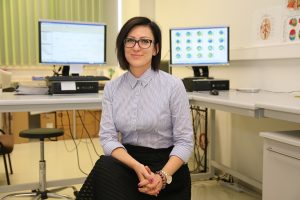Human brain is fascinating. As long as I have the energy, I’ll keep researching it. I’m particularly interested in the memory processes. I want to know how it happens that on the one hand we are able to analyse and interpret so much different information within such a short period of time, and on the other hand, despite the advanced and complex processes, it is relatively easy to influence what we have memorised.
Dr. Karina Maciejewska studies memory processes using specialist methods for analysing brain electrical activity (EEG and ERP). In order to increase her knowledge and enrich the range of methodological tools, she decided to go on a four-month scientific internship program in USA. She completed a part of her project in Dynamic Memory Lab research group supervised by Prof. Charan Ranganath at UC Davis Center for Neuroscience in California. However, she emphasizes that she wants to develop here, at the University of Silesia in Katowice, which is her alma mater.
|Małgorzata Kłoskowicz|
Your dissertation concerned the examination of bones of newborn rats whose mothers received antiretroviral drugs. The analysis served to increase the knowledge about potential side effects of strong drugs administered to pregnant women with HIV. However, after defending the doctoral degree, you changed the scientific discipline and began to examine memory processes. It seems that both subjects are very different from one another…
Dr. Karina Maciejewska: I am a graduate of medical physics. It is a very broad, interdisciplinary programme, which allows you to specialise in many scientific disciplines that are sometimes very distant from each other. After defending the doctoral degree, I decided to change the object of my research interest and commit myself to neuroscience, and speaking more precisely, to the fascinating and mysterious organ – the brain. So far, we have not recognised a majority of its mechanisms, and they all deserve attention. I focused on analysing the processes of memory – maybe because I sometimes have problems with it myself (laughs). That was a new issue for me, and so, to increase my knowledge faster, I decided to establish cooperation with one of the leading research centres specialised in this field.
You decided to take part in a short-term scientific internship. What are the advantages of this form of research support?
KM: The project thanks to which I went to USA for four months was co-financed in Miniatura 2 competition announced by the National Centre of Science. I contacted several scientists in various academic centres around the world – presenting my scientific interests and asking about the possibility of internship. I received several positive answers and ultimately chose US Davis Center for Neuroscience in California and Dynamic Memory Lab research group conducted by Prof. Charan Ranganath.
Four months is a short period to carry out research in neuroscience, but for me it proved sufficient to take part in classes and lectures, become familiar with their current research projects, increase my knowledge of the applied research techniques and, last but not least, open the way to continue certain scientific threads at home, at the University of Silesia in Chorzów.
We have a small laboratory equipped e.g. with electroencephalograph, which is enough for the performed analyses and obtained results to be significant in the context of scientific projects carried out anywhere in the world.
What sort of research did you conduct within that team?
KM: I got to know the current research projects and chose the one that seemed to be the closest to my interests. I started to cooperate with the Dynamic Memory Lab, which analyses long-term memory processes that help us store both recent and old information.
How are we able to recognise what we have already noticed?
KM: The scientists that I cooperated with look at two interesting processes of recognising information stored in our memory. The first of them is the so-called assessment of familiarity, which activates long-term memory. The second is recollection that enables to search through information resources in our memory and compare it with what we are currently perceiving. It turns out that these processes are accompanied by different brain activities. We can also notice the differences in our daily perceptual experience. How many times have we thought that we somehow know the person we have just met, although we can’t recall who this person is and what the relationship between us is? On other occasions we are able to recognise our colleague, friend or neighbour… How does it happen? We don’t know yet, but this is what our research is all about.
How can memory processes be studied?
KM: Prof. Charan Ranganath’s team mainly uses three research techniques. The scientists interpret brain electrical activity based on EEG and ERP studies, use magnetic resonance identifying the brain areas which activate during a particular process and conduct behavioural research on a group of volunteers, measuring parameters such as responsiveness, or the number of correct and incorrect responses per specific task. The data obtained in this way are correlated with each other, and the ultimate result is the model illustrating what brain connections are activated in the case of both processes.
I conduct research using electroencephalograph (EEG) and ERP-evoked potentials. I monitor the amplitude and frequency of brainwaves depending on the tasks related to the processes of assessing familiarity and recollection. I can carry out such research in our laboratory at the Institute of Physics in Chorzów. I have to say I have learnt a lot during my internship, also in terms of applying this technique for studying memory processes. Four months was enough, and it’s possible that the cooperation will be continued outside the project, which I’m very happy about.
How can the results of memory process analysis be applied?
KM: There are many options. Knowledge of processes observed in a healthy human organism may support the search of treatment methods for patients with various neurological disorders or inhibition of disease processes. Moreover, neuroscience allows to develop research on artificial intelligence. A good example is the so-called machine learning by modelling selected processes. The research results are definitely interesting for marketing experts who want to effectively attract the attention of consumers in order to persuade them to perform certain activities.
We may also touch upon more sensitive subjects, such as manipulation of our memory. For example, we know that the method of investigation and examination of witnesses may even have a significant impact on changing what the person interviewed remembers. I suppose that everyone of us has had a situation when we are sure that something happened in the past, but in reality it’s only an illusion. If we manage to learn the mechanisms governing the memory process, and I do believe that we will, we will understand why this happens.
Perhaps we will also gain tools for improving our memory, and I must say I count on it…







